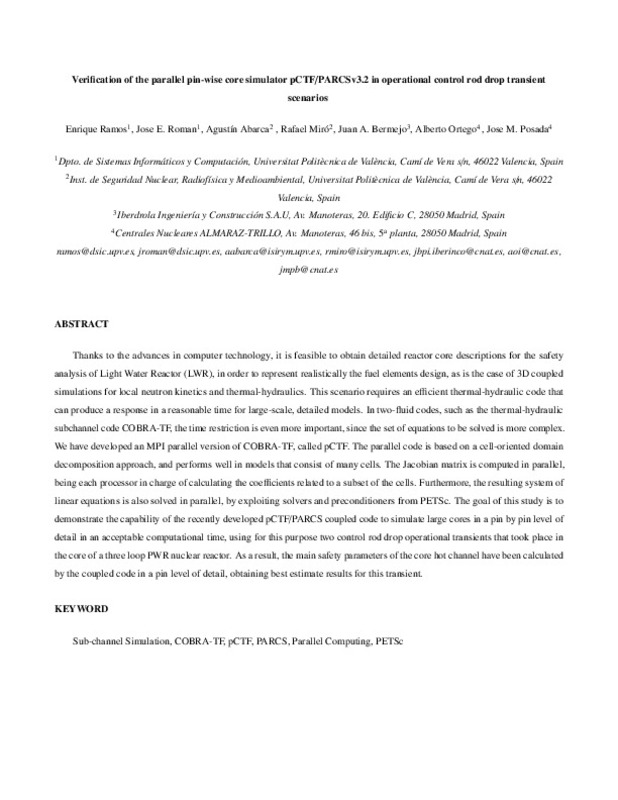JavaScript is disabled for your browser. Some features of this site may not work without it.
Buscar en RiuNet
Listar
Mi cuenta
Estadísticas
Ayuda RiuNet
Admin. UPV
Verification of the Parallel Pin-Wise Core Simulator pCTF/PARCSv3.2 in Operational Control Rod Drop Transient Scenarios
Mostrar el registro sencillo del ítem
Ficheros en el ítem
| dc.contributor.author | Ramos Peinado, Enrique
|
es_ES |
| dc.contributor.author | Roman Moltó, José Enrique
|
es_ES |
| dc.contributor.author | Abarca Giménez, Agustín
|
es_ES |
| dc.contributor.author | Miró Herrero, Rafael
|
es_ES |
| dc.contributor.author | Bermejo, Juan A.
|
es_ES |
| dc.contributor.author | Ortego, Alberto
|
es_ES |
| dc.contributor.author | Posada-Barral, Jose Maria
|
es_ES |
| dc.date.accessioned | 2020-11-17T04:32:49Z | |
| dc.date.available | 2020-11-17T04:32:49Z | |
| dc.date.issued | 2017 | es_ES |
| dc.identifier.issn | 0029-5639 | es_ES |
| dc.identifier.uri | http://hdl.handle.net/10251/155130 | |
| dc.description | This is an Accepted Manuscript of an article published by Taylor & Francis in Nuclear Science and Engineering on 2017, available online: https://www.tandfonline.com/doi/full/10.1080/00295639.2017.1320892 | |
| dc.description.abstract | [EN] Thanks to advances in computer technology, it is feasible to obtain detailed reactor core descriptions for safety analysis of the light water reactor (LWR), in order to represent realistically the fuel elements design, as is the case for three-dimensional coupled simulations for local neutron kinetics and thermal hydraulics. This scenario requires an efficient thermal-hydraulic code that can produce a response in a reasonable time for large-scale, detailed models. In two-fluid codes, such as the thermal-hydraulic subchannel code COBRA-TF, the time restriction is even more important, since the set of equations to be solved is more complex. We have developed a message passing interface parallel version of COBRA-TF, called pCTF. The parallel code is based on a cell-oriented domain decomposition approach, and performs well in models that consist of many cells. The Jacobian matrix is computed in parallel, with each processor in charge of calculating the coefficients related to a subset of the cells. Furthermore, the resulting system of linear equations is also solved in parallel, by exploiting solvers and preconditioners from PETSc. The goal of this study is to demonstrate the capability of the recently developed pCTF/PARCS coupled code to simulate large cores with a pin-by-pin level of detail in an acceptable computational time, using for this purpose two control rod drop operational transients that took place in the core of a three-loop pressurized water reactor. As a result, the main safety parameters of the core hot channel have been calculated by the coupled code in a pin level of detail, obtaining best estimate results for this transient. | es_ES |
| dc.description.sponsorship | This work has been partially supported by the Universitat Politecnica de Valencia under Projects COBRA_PAR (PAID-05-11-2810) and OpenNUC (PAID-05-12), and by the Spanish Ministerio de Economia y Competitividad under Projects SLEPc-HS (TIN2016-75985-P) and NUC-MULTPHYS (ENE2012-34585). | es_ES |
| dc.language | Inglés | es_ES |
| dc.publisher | Taylor & Francis | es_ES |
| dc.relation.ispartof | Nuclear Science and Engineering | es_ES |
| dc.rights | Reconocimiento - No comercial - Sin obra derivada (by-nc-nd) | es_ES |
| dc.subject | Subchannel simulation | es_ES |
| dc.subject | Parallel computing | es_ES |
| dc.subject | COBRA-TF | es_ES |
| dc.subject.classification | INGENIERIA NUCLEAR | es_ES |
| dc.subject.classification | CIENCIAS DE LA COMPUTACION E INTELIGENCIA ARTIFICIAL | es_ES |
| dc.title | Verification of the Parallel Pin-Wise Core Simulator pCTF/PARCSv3.2 in Operational Control Rod Drop Transient Scenarios | es_ES |
| dc.type | Artículo | es_ES |
| dc.identifier.doi | 10.1080/00295639.2017.1320892 | es_ES |
| dc.relation.projectID | info:eu-repo/grantAgreement/UPV//PAID-05-12/ | es_ES |
| dc.relation.projectID | info:eu-repo/grantAgreement/UPV//PAID-05-11-2810/ | es_ES |
| dc.relation.projectID | info:eu-repo/grantAgreement/MINECO//TIN2016-75985-P/ES/SOLVERS DE VALORES PROPIOS ALTAMENTE ESCALABLES EN EL CONTEXTO DE LA BIBLIOTECA SLEPC/ | es_ES |
| dc.relation.projectID | info:eu-repo/grantAgreement/MINECO//ENE2012-34585/ES/Desarrollo de una plataforma multifísica de altas prestaciones para simulaciones Termohidráulico-Neutrónicas en ingeniería nuclear/ | es_ES |
| dc.rights.accessRights | Abierto | es_ES |
| dc.contributor.affiliation | Universitat Politècnica de València. Departamento de Sistemas Informáticos y Computación - Departament de Sistemes Informàtics i Computació | es_ES |
| dc.contributor.affiliation | Universitat Politècnica de València. Departamento de Ingeniería Química y Nuclear - Departament d'Enginyeria Química i Nuclear | es_ES |
| dc.description.bibliographicCitation | Ramos Peinado, E.; Roman Moltó, JE.; Abarca Giménez, A.; Miró Herrero, R.; Bermejo, JA.; Ortego, A.; Posada-Barral, JM. (2017). Verification of the Parallel Pin-Wise Core Simulator pCTF/PARCSv3.2 in Operational Control Rod Drop Transient Scenarios. Nuclear Science and Engineering. 187(3):254-267. https://doi.org/10.1080/00295639.2017.1320892 | es_ES |
| dc.description.accrualMethod | S | es_ES |
| dc.relation.publisherversion | https://doi.org/10.1080/00295639.2017.1320892 | es_ES |
| dc.description.upvformatpinicio | 254 | es_ES |
| dc.description.upvformatpfin | 267 | es_ES |
| dc.type.version | info:eu-repo/semantics/publishedVersion | es_ES |
| dc.description.volume | 187 | es_ES |
| dc.description.issue | 3 | es_ES |
| dc.relation.pasarela | S\351348 | es_ES |
| dc.contributor.funder | Universitat Politècnica de València | es_ES |
| dc.contributor.funder | Ministerio de Economía y Competitividad | es_ES |
| dc.description.references | Cuervo, D., Avramova, M., Ivanov, K., & Miró, R. (2006). Evaluation and enhancement of COBRA-TF efficiency for LWR calculations. Annals of Nuclear Energy, 33(9), 837-847. doi:10.1016/j.anucene.2006.03.011 | es_ES |
| dc.description.references | Ramos, E., Roman, J. E., Abarca, A., Miró, R., & Bermejo, J. A. (2016). Control rod drop transient analysis with the coupled parallel code pCTF-PARCSv2.7. Annals of Nuclear Energy, 87, 308-317. doi:10.1016/j.anucene.2015.09.016 | es_ES |
| dc.description.references | T. DOWNAR et al. “PARCS v2.7 U.S. NRC Core Neutronics Simulator: User Manual” (2006). | es_ES |
| dc.description.references | T. DOWNAR et al. “PARCS v2.7 U.S. NRC Core Neutronics Simulator: Theory Manual” (2006). | es_ES |







![[Cerrado]](/themes/UPV/images/candado.png)

